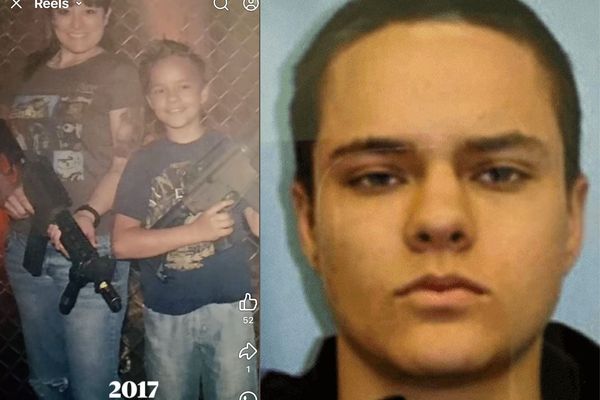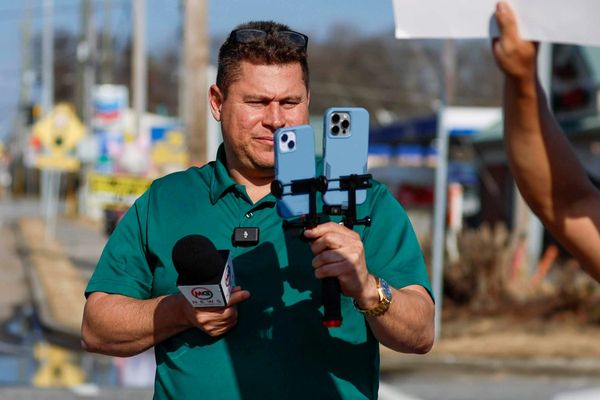
The HMAS Armidale was sinking fast. It had been hit by torpedoes from Japanese bombers. Ordinary seaman Edward “Teddy” Sheean, 18, was wounded but he strapped himself to his anti-aircraft gun.
Sheean kept shooting, trying to take down the enemy and keep his crew safe, as the ship slipped beneath the water.
One hundred men died in the attack – 40 Australians and 60 Netherlands East Indies personnel; 49 survived after days at sea.
It was one of Australia’s worst naval losses in the second world war.
One of the survivors, leading seaman Leigh Bool, later said Sheean (“not long at sea, who refused to leave the ship”) was the “hero of the battle”.
“Sheean had no chance of escape,” he said.
“Strapped to his anti-aircraft gun, he blazed away till the last. One of the [Japanese] bombers, hit by his gun, staggered away trailing smoke, just skimming the surface until it crashed with a mighty splash about a quarter mile away.”
In 2020, Sheean was awarded a posthumous Victoria Cross, the first time one was given to a member of the Royal Australian Navy. He had already had one of the navy’s Collins Class submarines named after him.

The Armidale, one of Australia’s most significant shipwrecks and most extraordinary stories, was lost on 1 December 1942.
More than 80 years later, authorities say it could soon be found in the seas near Timor-Leste.
But if Australia can find it, there’s a risk bad actors could too. Shipwrecks are at risk of being looted. The HMAS Perth has been torn apart by thieves and the AE1 – Australia’s first submarine – is vulnerable.
Pressure is building for Australia to ratify the Unesco convention for the protection of underwater heritage, which has been put in place to stop pirates and trophy hunters from looting shipwrecks, and disturbing the bodies of drowned sailors in the process.

At a recent hearing into the convention, one of the nation’s top maritime archaeology experts said it was “likely” an unnamed Australian vessel would be found “in the near future”.
Andrew Viduka, the federal water department’s assistant director of underwater cultural heritage, said when the vessel was found, it was likely to “be at a diveable depth” and that the convention would help Australia work with Timor-Leste to protect it.
“Our problem right now is that we are aware that it is more likely to be towards Timor-Leste than us,” he said.
“The logic of the convention and the convention’s principles, the training and capacity-building and all that, is exactly the pathway we need to prepare should something be found like that, if we do not want it to be looted or the human remains of our sailors to be lost.”
The department has now confirmed to Guardian Australia that Viduka was referring to the Armidale.
The Armidale was on a mission to evacuate troops and civilians from Betano Bay, Timor, when it was attacked.

Photograph: David Dare Parker/The Guardian
The Japanese launched waves of aerial attacks, bombing, torpedoing and machine gunning the Armidale, which kept plugging on. But eventually two torpedoes crippled the corvette, and the captain gave the order to abandon ship.
As the men went overboard, as they clung to rafts and boats, the Japanese continued to strafe the survivors with machine guns. Sheean stayed at his post and kept firing.
The next day, 2 December, the captain took the wounded on the motor boat and went looking for help.
Two days later, after no help arrived, the whaler boat took off with non-wounded, also looking for help. Both the boat and the whaler were rescued.
A harrowing photo, taken from a plane that could not save them because of the rough seas, shows the remaining men squashed together on a raft, surrounded by ocean.
It was the last time they were seen.
Dr James Hunter, curator of naval heritage and archaeology at the Australian National Maritime Museum, said he would love to see the wreck found and documented both for the descendants and the historical knowledge.
“For me, the real big thing out of a discovery like that is being able to point to a place on a map for descendants and say this is where they are,” he says.
“That’s a really powerful thing for people.
“We know quite a lot about what happened to it. There are probably details we don’t know. We may find damage to the ship that may not have been mentioned in accounts of the aerial attack.”
But, Hunter warns, it may not be that easy to pinpoint. Many people believe the Armidale came to rest in deep water, which would make it much harder. Then there are the seabeds, which can be like “underwater mountain ranges”.

Shipwreck hunters first do a “desktop survey”, Hunter says, going through all the archival, historical material there is, to narrow down a search zone. They might talk to fishers, ask them if there’s a spot they get consistently snagged on.
They start to gather bathymetric data, the topography of the ocean floor, using sonars and multi-beam echo sounders to build a 3D picture of the sea bed, trying to find “something that looks shipwrecky”. Or they might use a magnetometer to detect iron or steel.
Then they establish a “bounding box”, an area they can systematically search in a process they call “mowing the lawn”.
The next step is to send down a scuba diver, if the water’s shallow enough. A remotely operative vehicle (ROV) or submersible with high-definition cameras if it’s deeper. And then you hope you end up with pictures and video of the sunken ship.
“A ship like Armidale, we know a lot about it historically, we know what it’s armed with,” Hunter says.

“If it is in deep water, which I suspect it would be, you could bring the ROV around to the stern and see the name on the back.”
Lance corporal John Callander was an army man (part of what was known as the Australian Imperial Force). He was one of those on the whaler, one of the survivors.
His son, Angus Callander, is the president of the HMAS Armidale Association. He says the story of the Armidale is “one of the great stories of survival at sea”.
“My father, it was just pure luck he survived,” he says.
“There were nearly 50 men killed in action on day one. Over 100 men were left in the water. They made a collective decision that the captain best make Bathurst Island with the wounded.
“On day four, those left behind realised the captain may not have made it. There was a boat just below the water line. It was wooden, full of bullet holes.

“[At this point] they hadn’t slept for four or five days. They managed to raise it by pushing it on the raft, patched up the holes and got it floating.
“They picked the fittest – my father was selected – and headed off. They were subsequently found.”
Callander’s father was in the water as the HMAS Armidale went down, and he saw Sheean’s last moments.
Sheean was still strapped to his gun, and the magnesium flares from his bullets were visible as he kept up the counter-attack on the Japanese. Callander’s father told the son what he saw.
“I remember him telling me that when the ship went under the water line, they could still see these tracer bullets coming up – from under the water,” Callander says.







